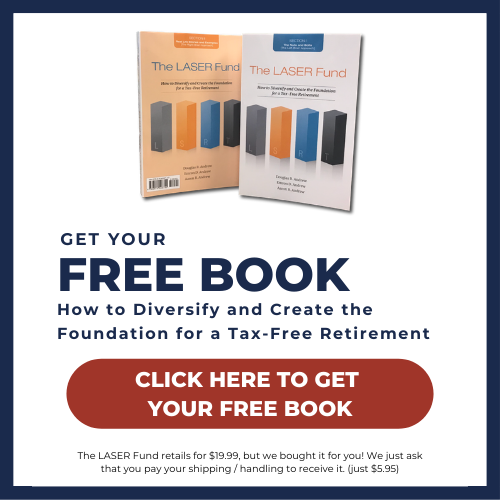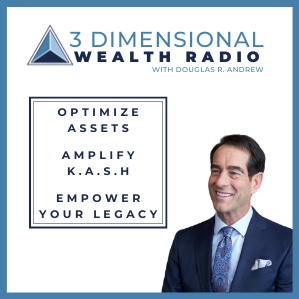There’s an adage: “Good, better, best. Never let it rest. Never let it rest ‘til good gets better and better gets best.” While there are lots of ways to save for retirement–some of them a valuable part of a balanced approach–is there a “best way”? And if so, what is it?
To get there, let’s start by looking at the four phases of retirement planning:
- Contribution Phase – This is when you contribute money toward your future. It could be in any number of financial vehicles, and for millions of Americans, it’s in traditional accounts like IRAs and 401(k)s.
- Accumulation Phase – In the accumulation phase, the money set aside in your financial vehicles is (hopefully) growing with interest or dividends.
- Distribution Phase – In this phase, you’re accessing the money to use for income or other needs.
- Transfer Phase – This phase follows your passing, when the money in your accounts passes along to your heirs.
At our events, we often ask, “What is the most important phase?”
A lot of times the audience will say, “Well, the accumulation phase, because that’s when my money needs to grow,” or they may say, “The distribution phase, because that’s when I’m pulling out money for retirement.”
To arrive at the ultimate answer, you have to ask, “What is the end goal?”
The end goal is to have income that will last as long as you do.
Now what’s the best way to arrive at that goal? Here’s where I’ll share a metaphor I use in my book, “The LASER Fund,” something I call the Million-Dollar Dash.
THE MILLION-DOLLAR DASH
Imagine a racetrack where the goal is to cross the finish line with at least $1 million dollars net after tax, after fees–money that can generate hopefully $80,000 to $100,000 of tax-free income that will last as long as you do.
So let’s get started, and I’ll talk about how you can get there by sprinting, instead of crawling, walking, or jogging.
CRAWLING TOWARD RETIREMENT
Taxed-as-earned investments would be like “crawling” toward the retirement finish line. With these kinds of accounts, money set aside in taxed-as-earned investments is contributed with after-tax dollars, and any interest or dividends are taxed each year as they are earned. But the taxes don’t stop there.
Any capital gains are also taxed during distribution, and upon death your money is subject to income tax and possibly estate tax. Unfortunately this is one of the most common ways Americans save for retirement, in traditional vehicles like mutual funds and savings accounts at banks or credit unions, and typical taxable investments.
Let’s use an example to see why it is so slow-going. Let’s say you have $1 doubling in a tax-favored environment in each period for twenty periods–by the end of the twenty periods, you would end up with over $1 million. But if your dollar were doubling in a taxed-as-earned environment, where you are taxed at, say, 33.3% on your earnings, you would only have a 67-cent gain. After twenty periods, you’d only have just over $27,000. That’s a lot less than $1 million. That’s like getting 2.7% of the way around the race track.
WALKING TOWARD RETIREMENT
When you set aside money with after-tax dollars into tax-deferred investments (such as tax-deferred annuities), these kinds of vehicles are only tax-favored during the accumulation phase. Upon distribution from a tax-deferred annuity, the IRS taxes all withdrawals or distributions on a LIFO basis (which means last-in, first-out). This is like “walking” toward the finish line—you’re only going to get about one-third of the way around the track.
JOGGING TOWARD RETIREMENT
How about a nice jog toward that retirement finish line? If that sounds good, you’ll be joining the millions of Americans who set aside pre-tax dollars in traditional IRAs and 401(k)s. With these kinds of vehicles, you’re able to save with 100% tax-advantaged dollars on the front end.
But don’t forget that you must pay taxes when you access your money. You’re essentially electing to have a tax break on the front in exchange for paying tax on the back end.
SPRINTING TOWARD RETIREMENT
Now I ask, why crawl, walk, or jog when you could sprint? This happens when you contribute after-tax dollars in a tax-favored environment, when you can access it tax-free, and when it transfers income-tax-free to your heirs upon your passing. This is where unique vehicles, like a properly structured, maximum-funded Indexed Universal Life policy (what I call The LASER Fund) can help you win the retirement race.
Good, better, best. Never let it rest. Never let it rest till good gets better and better gets best. As you can see, not all financial vehicles provide the same momentum, especially with the winds of taxes blowing your way.
This is why it behooves you to learn as much as you can about your options, weighing the pros and cons of each vehicle for your needs and goals, developing a balanced approach.
WANT TO LEARN MORE?
Watch the Video – Watch the related YouTube video to see me explain “What Are the Best Ways to Save for Retirement?” (and while you’re there, be sure to subscribe to my YouTube channel so you don’t miss a thing!).
Elevate Your Financial Dimension – Find out how you can improve your Financial Dimension journey and seize the liquidity, safety, predictable rates of return, and tax advantages of a LASER Fund. Explore the in-depth financial strategies and learn from real-life client experiences by claiming your free copy of “The LASER Fund” book at LASERFund.com. Just pay for shipping and handling, and we will send it to you, absolutely free.
Join a Webinar – Want to find out if a LASER Fund (a maximum-funded, properly structured indexed universal life insurance policy) is right for you? Join us for an upcoming webinar where you can explore these strategies.


